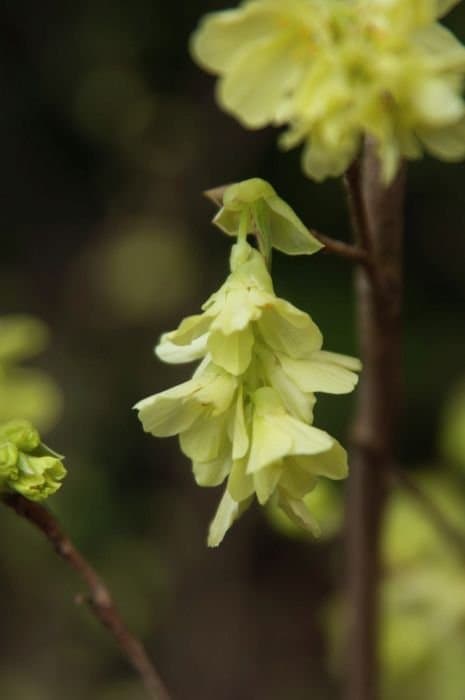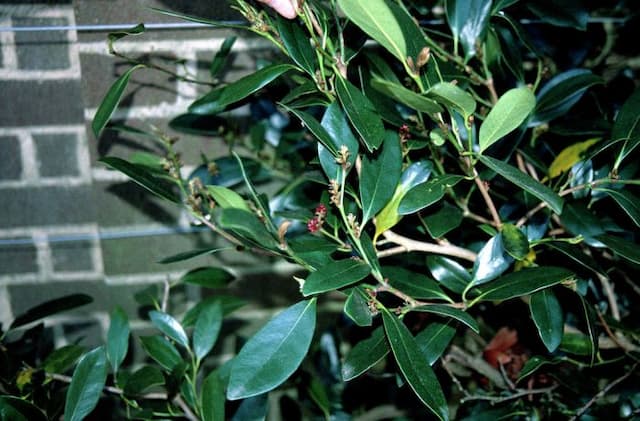Oriental Sweetgum Liquidambar orientalis

ABOUT
The Liquidambar orientalis, commonly known as Oriental sweetgum, is a deciduous tree noted for its beautiful glossy green leaves and exfoliating bark. The leaves resemble the shape of a star with multiple pointed lobes, usually five to seven, and turn into a mix of rich purple, red, and orange colors as the seasons transition into autumn. The foliage is accompanied by small, inconspicuous flowers that give way to hard, spiky seed pods which can persist on the tree into winter. The bark of the Oriental sweetgum is gray and deeply furrowed, providing a striking texture and visual interest even when the tree is leafless. This bark can peel away in narrow strips to reveal a smoother, lighter underbark. These features contribute to the Oriental sweetgum's aesthetic appeal in various landscapes.
About this plant
 Names
NamesFamily
Altingiaceae.
Synonyms
Oriental Sweetgum, Turkish Sweetgum, Levant Storax.
Common names
Liquidambar imberbis, Altingia excelsa, Altingia orientalis, Liquidambar altingiana, Liquidambar imberbe.
 Toxicity
ToxicityTo humans
Oriental sweetgum is generally not toxic to humans. However, if any part of the plant is ingested in large quantities, it might cause some gastrointestinal discomfort such as nausea or vomiting due to its astringent qualities. It is not commonly associated with serious poisoning or toxic consequences in humans.
To pets
Oriental sweetgum is not considered highly toxic to pets. However, as with many plants, the ingestion of leaves or seeds could potentially cause gastrointestinal upset, such as vomiting or diarrhea, particularly in small animals or those with sensitive systems. There is no commonly known severe poisoning linked to this plant for pets.
 Characteristics
CharacteristicsLife cycle
Perennials
Foliage type
Deciduous
Color of leaves
Green
Height
40-60 feet (12-18 meters)
Spread
20-25 feet (6-7.6 meters)
Plant type
Tree
Hardiness zones
7-10
Native area
Southwest Asia
Benefits
 General Benefits
General Benefits- Erosion control: Liquidambar orientalis, commonly known as Oriental sweetgum, has a robust root system that helps stabilize soil and prevent erosion.
- Habitat for wildlife: The tree offers habitat and food sources for various birds and small mammals with its seed pods and dense foliage.
- Aesthetic appeal: With its star-shaped leaves and attractive fall colors, Oriental sweetgum adds visual interest to landscapes throughout the seasons.
- Shade production: The broad canopy of the Oriental sweetgum provides ample shade, creating cooler microclimates and reducing the need for air conditioning in nearby spaces.
- Wood production: The wood of Oriental sweetgum is valued for its use in fine furniture, veneer, and cabinetry, offering economic benefits through its timber.
 Medical Properties
Medical Properties- Antimicrobial: Liquidambar orientalis has been traditionally used for its antimicrobial properties, which may help in fighting against bacteria and fungi.
- Anti-inflammatory: The plant may possess anti-inflammatory properties which can alleviate inflammation in the body.
- Analgesic: It is sometimes used for its pain-relieving effects to soothe aches and pains.
- Expectorant: The medicinal extracts from the plant can act as an expectorant, helping in the relief of cough and congestion related to colds.
- Antioxidant: As with many plants, Liquidambar orientalis may contain antioxidants which can help in neutralizing harmful free radicals in the body.
- Astringent: The astringent quality of the plant is used for tightening tissues and reducing secretions such as mucus.
 Air-purifying Qualities
Air-purifying QualitiesThis plant is not specifically known for air purifying qualities.
 Other Uses
Other Uses- Perfume Fixative: The aromatic properties of oriental sweetgum resin are often utilized as a fixative in perfumes, enhancing the longevity of scents on the skin.
- Waterproofing: The resin from the oriental sweetgum tree is sometimes used in the production of waterproofing materials for traditional crafts and textiles due to its hydrophobic nature.
- Insect Repellent: The aromatic scent of the oriental sweetgum can be used to repel insects, making it useful in the creation of natural insect repellent products.
- Flavoring Agent: In some cultures, the resin from oriental sweetgum is used as a flavoring agent for food and beverages, imparting a unique taste and aroma.
- Incense: The resin, known for its rich fragrance, is used in incense for religious and spiritual ceremonies, as well as for aromatherapy.
- Adhesive: The sticky resin can serve as a natural adhesive in traditional crafting or as a binding agent in various applications.
- Woodworking: The wood of the oriental sweetgum tree is prized for its fine grain and workability, making it suitable for high-quality furniture and ornamental woodworking.
- Art Supplies: The resin is used in the production of artist's media, such as varnishes and glazes that protect paintings and enhance their brilliance.
- Bookbinding: Historically, the resin might have been used in the process of bookbinding as an adhesive to secure pages and provide durability to the bindings.
- Dyeing: The leaves and bark of the oriental sweetgum may be used in natural dyeing processes, giving fabrics and materials a range of warm, earthy tones.
Interesting Facts
 Feng Shui
Feng ShuiThe Oriental Sweetgum is not used in Feng Shui practice.
 Zodiac Sign Compitability
Zodiac Sign CompitabilityThe Oriental Sweetgum is not used in astrology practice.
 Plant Symbolism
Plant Symbolism- Healing: Liquidambar orientalis, commonly known as Oriental sweetgum, has been used in traditional medicine, suggesting a symbolism of healing and health.
- Longevity: The Oriental sweetgum is a long-lived tree, which can symbolize endurance and longevity.
- Protection: The sturdy nature of the Oriental sweetgum and its resilient wood might be associated with strength and protection.
- Change: The Oriental sweetgum is notable for its vibrant autumn leaf colors, representing change and adaptability.
- Balance: The star-shaped leaves of the Oriental sweetgum might symbolize balance and harmony in life.
 Water
WaterOriental sweetgum trees need consistent watering to maintain moist soil, especially during their first few years of growth. Water young trees deeply once a week with about 15 gallons per watering session. As they mature, they will require less frequent watering since their root systems are more established. Typically, watering once every two to three weeks with 20-30 gallons should be sufficient, depending on rainfall and soil conditions. During the hotter months, monitor the moisture level of the soil more frequently and adjust your watering schedule accordingly to prevent the soil from drying out completely.
 Light
LightOriental sweetgum thrives in full sun to partial shade. The ideal spot for this tree is an area where it receives at least 4 to 6 hours of direct sunlight daily. They are adaptable to various light conditions, but too much shade may hinder their growth and reduce the vibrancy of their fall foliage.
 Temperature
TemperatureOriental sweetgum trees are hardy and can tolerate a wide range of temperatures, performing best in USDA zones 5 through 9. The ideal temperature range for these trees is between 50°F and 90°F. They can withstand occasional dips down to about -10°F, but temperatures below this can be harmful. Similarly, temperatures consistently above 100°F may stress the tree.
 Pruning
PruningPruning is vital for maintaining the structure and health of Oriental sweetgum trees. Prune to remove dead or damaged branches, to shape the tree, and to encourage new growth. The best time for pruning is during the tree's dormancy period in late winter or early spring before the new leaves appear. Pruning should be done every 3 to 5 years to keep the tree looking its best and to prevent potential problems with overgrowth.
 Cleaning
CleaningAs needed
 Soil
SoilThe best soil mix for Oriental Sweetgum should be rich, moist, and well-draining, with a slightly acidic to neutral pH ranging from 5.5 to 7.5. A mix of garden soil, compost, and perlite or sand will improve structure and nutrient content.
 Repotting
RepottingOriental Sweetgum trees are typically not repotted as they are large landscape trees. However, if grown in a large container, repotting every 3-5 years or when rootbound is recommended.
 Humidity & Misting
Humidity & MistingOriental Sweetgum prefers moderate to high humidity levels; however, as an outdoor tree, it generally adapts to local conditions without needing specific humidity adjustments.
 Suitable locations
Suitable locationsIndoor
Not suitable for indoor growth; needs outdoor space.
Outdoor
Plant in full sun, deep soil, water regularly.
Hardiness zone
7-10 USDA
 Life cycle
Life cycleSweetgum, scientifically known as Liquidambar orientalis, begins its life cycle with seed germination, which requires a warm and moist environment to successfully sprout. After germination, the seedling growth phase involves the development of roots, stems, and leaves, enabling it to photosynthesize and grow into a juvenile plant. As it matures into an adult tree, it undergoes vegetative growth producing a thick trunk and a canopy with star-shaped, glossy leaves. Reproductive maturity is reached in several years, when the tree starts to produce its distinctive spiky fruit capsules that contain numerous seeds, which are then dispersed by wind or animals. Seasonally, Liquidambar orientalis experiences a leaf change with vivid autumn colors before shedding its foliage in preparation for winter dormancy. Finally, in its potentially centuries-long lifespan, the tree continues a cycle of growth, reproduction, and dormancy until it eventually succumbs to environmental factors or old age.
 Propogation
PropogationPropogation time
Spring-Early Summer
Sweet gum, scientifically known as Liquidambar orientalis, can be propagated by seed, but the most popular method is through semi-hardwood cuttings. This technique is best performed in late summer. Cuttings should be taken from the current year's growth, selecting healthy, disease-free branches. Cut a section approximately 4 to 6 inches (10 to 15 centimeters) long, making sure it includes at least two or three leaf nodes. The lower leaves are removed, and the cutting base is often treated with a rooting hormone to encourage root development. The cutting is then placed in a well-draining soil mix or sterile propagation medium and kept under high humidity and indirect light until roots have formed, after which it can be transplanted to a more permanent location.









